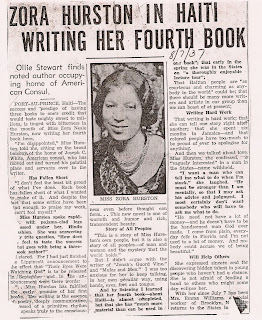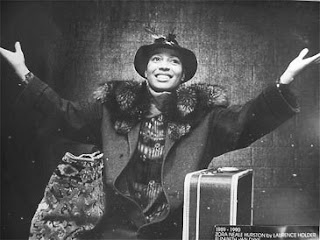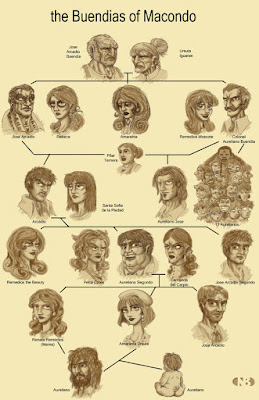Among the most dazzling gems of American literature, Zora
Neale Hurston’s Their Eyes Were Watching God stands confidently in the
company of such tautly shimmering masterpieces as Nathaniel Hawthorne’s The
Scarlet Letter, Mark Twain’s The Adventures of Huckleberry Finn, F.
Scott Fitzgerald’s The Great Gatsby, Nathanael West’s Miss Lonelyhearts,
J. D. Salinger’s The Catcher in the Rye, Thomas Pynchon’s The Crying
of Lot 49, and Marilynne Robinson’s Housekeeping, each of these
novels’ slim volumes serving as the receptacle of entire universes that have
been hewn with diamond-tipped virtuosity and forged into eternal works of art.
First published in 1937, Their Eyes Were Watching God
was a financial success, but it was extremely unpopular among many of Hurston’s
African-American peers. Hurston wrote the novel in what today is known as
Ebonics, and authors such as Richard Wright and Ralph Ellison lambasted it as
backwards and Uncle-Tommish, a work that they felt didn’t help African-American
writers gain any kind of serious literary voice or stature. Compounding the
issue was the fact that Hurston was an anti-integrationist Republican who was
lauded by whites who shared her beliefs, much in the same way that some of Malcolm
X’s views would later be embraced by White Supremacists. It’s possible that
today Hurston would simply be considered Afrocentric, but in her time her keen
focus on African-American culture and dialect—she was a highly educated
anthropologist and folklorist—caused her to be criticized of “ghettoizing” the
literature of a people that was desperately trying to escape marginalization.

Again, today’s
perspective might argue that rather than trying to write “protest” novels that
exposed wrongs and promoted change, she was simply portraying and celebrating a
culture that she felt was as valid and valuable and as worthy of high artistic
representation as any other. But she didn’t live in our time, of course, and
once her white admirers lost interest in her, she descended into obscurity and
eventually died penniless in 1960, to be buried in an unmarked grave and almost
totally forgotten.
Her work had
been long out of print by the time of her death, but thanks to the efforts of
Alice Walker and others in the 1970s, Hurston’s books received a second chance
at life, and since then Their Eyes Were Watching God has singled itself
out as a particularly astonishing work of art and has finally ascended to its
deserved status as one of America’s true literary masterpieces. Recently
reading this amazing book for the third time, it struck me as a strong
contender for Greatest American Novel, matching Huck Finn’s oscillating complexity and maybe even surpassing The Scarlet Letter’s magical
seamlessness.

Written
while Hurston was doing field research in Haiti, Their Eyes Were Watching
God takes place in Florida and tells the story of Janie Crawford, following
her through her childhood and through three very different marriages, from the
vantage-point of a forty-something Janie who’s telling her friend Phoeby about
her life so that Phoeby can tell the gossiping community the truth about her. Only
at times voiced in Janie’s direct speech, with Hurston very sophisticatedly refracting
most of the novel through her main character’s unique mind and history to project
an inventively original narrative language onto the page, Janie’s singular
existence strikes the reader as startlingly unique, her unforgettably distinct personality
comparable to that of Huckleberry Finn or Holden Caulfield, and her story is as
equally penetrating as the language that tells it.
 |
| “Oh to be a Pear Tree,” Ann Tanksley, 2009 |
Seeing the
young Janie’s budding sexuality beginning to break loose, her grandmother
marries her off young in an attempt to give her a stable life, but the girl’s
early erotic reveries under a wild pear tree, watching the bees penetrate the
calyxes in an orgiastic swarm, permanently orient her personality so that she
yearns for both stimulation and satisfaction, leading her to follow a number of
forking paths in her attempt to get her adult self back to that wild garden. Simply
abandoning her first husband for the more ambitious Joe Starks, the still-young Janie accompanies her second husband as he lights out to found his own
mini-universe, an all-Black town called Eatonville, which was a fictionalized version of a real Eatonville in Florida that Hurston cleverly kept the name of because of its serendipitous invocation of an “Eden town.” Setting himself up as a
kind of Old Testament creator—note the ceremony that he makes when he installs
the town’s first street lamp, letting
there be light, as well as his favorite exclamation when
agitated: “I god,” rather than “my god,” as if in anger he were merely invoking
himself—he also exemplifies all of the Hebrew god’s childish narcissism,
jealously demanding more and more devotion from Janie while offering none in return,
as if doting attention were his birthright. After twenty miserable, abusive
years together, with her pedestalled position as shopgirl in Joe’s store
offering her no chance for self-expression or satisfaction, he finally dies—but
not before she finally upbraids him for “worshippin’ de works of yo’ own
hands”—and Janie suddenly finds herself financially independent and the master of
her own world, and consequently in great demand among the entire state’s
suitors, who all want to put her back in her place.
 |
Michael Ealy and Halle Berry in the 2005 film
version of Their Eyes Were Watching God |
Among her more persistent romantic supplicants, pressing his cause distantly
through Janie’s friend Phoeby, is an undertaker from Sanford, but Janie tells
Phoeby that she loves her freedom too much to think about anything like that
just yet. Only one page later a younger man calling himself Tea Cake comes into
her store and wakes up her long-dormant curiosity about life, treating her as
the equal she is and rapidly opening up capacities in her that she’d never
expected to find in herself. He teaches her to play checkers, which had been
something her former husband had excluded her from, and she joyfully reflects to
herself that “Somebody wanted her to play. Somebody thought it natural for her
to play.” He teaches her to shoot a gun, and she quickly becomes a better shot
than him. Not patronizing her at all, but rather marveling at how exceptional
she is and how well matched they are, Tea Cake draws her out and shows her a
new way of life, and a new self in herself that she’d almost stopped thinking
she could ever achieve. Finally marrying for love—and also for the wild lust
that had lain long dormant inside of her—Janie embarks on a life of her own choosing.
Tea Cake is an unreliable drifter, and their relationship is far from perfect,
but their love is all the more powerful and true for its flaws and
fluctuations, and the couple gets to experience each other to the most profound
depths.
As when Huck and Jim’s boat-trip down the Mississippi takes The Adventures of Huckleberry Finn into the strangest and most relative territory, the overwhelming reality and surreality of nature suddenly heighten Their Eyes Were Watching God to a near-dreamlike state when the 1928 Okeechobee hurricane hits Florida and subjects all living beings to its mindless and merciless power. Janie and Tea Cake survive, but after a biblically freakish series of occurrences leads Tea Cake to be bitten by a rabid dog that he’s trying to protect her from during the hurricane’s hallucinatory aftermath, Janie is forced to use her recently learned handiness with a gun to shoot him in self-defense when he goes mad from contracting the disease and tries to kill her. A subsequent trial acquits her of murder, but afterward Janie is tired of life and wants to recede from it, and so she returns to Eatonville and tells Phoeby her story.
 |
| Untitled, Jerry Pinkney, 1991 |
One
of the rarely discussed enigmas of Their Eyes Were Watching God is that
after Janie shoots Tea Cake, she holds him in her arms while he madly sinks his
teeth into her during his death throes. The novel never again discusses this bite, which may
or may not have transmitted the disease to Janie. Hurston cleverly arranges the
events between the bite and Janie’s resigned retirement to be almost the exact same
amount of time that it took for Tea Cake to develop symptoms, and the fact that
the novel very deliberately doesn’t address Janie’s wound anywhere in its final
pages leaves a vast ambiguity. Does Janie choose to follow Tea Cake in death?
Is this novel, a story told to Phoeby—whose name means “moon” and suggests the reflection
of light—her last testament? Or is she perhaps just telling her tale without
knowing for sure what kind of life or death awaits her after she survives these
crucial events?
Discussed even less often than this question is Hurston’s extraordinarily sly and sophisticated literary program for the novel. Using names and imagery that call up a vivid tapestry of literary and biblical associations, she asserts herself as one of the most cannily allusive of the great modernist masters. Joe Starks’ role as Old Testament deity is fairly overtly laid out, but Tea Cake’s personality and role seem so wholly and vividly original that readers can easily overlook the many layers of symbolism that Hurston builds around him. The reference that’s hiding in the plainest sight is that Tea Cake’s name is an allusion to the most famous tea cake in all of literature: the madeleine in Proust’s In Search of Lost Time. In Proust’s associative cosmos, an entire 4,000+ page novel arises from the sense memories that spring from a chance combination of dipping a madeleine cookie into a cup of tea, a blend of flavors that his narrator hadn’t tasted in decades and that resurrects in him an entire universe of lost time within his super-sensitive frame. The word “resurrects” is key to the association, because in Proust the madeleine and tea are a kind of secular Eucharist, a bread and wine that reclaim new life within the seemingly dead. With this as part of Tea Cake’s literary baggage, Hurston has him usher in a new dispensation for Janie, figuratively saving her life as he delivers her back to the lost garden and then literally saving it when he takes the dog bite that in the hurricane’s oneiric aftermath seemed to have been destined for her. While Hurston never heavy-handedly makes him into a Christ figure, making sure that he’s his own vividly original entity and that her playful allusions remain mere shading, she nevertheless uses a lot of the same imagery for him that’s typically associated with Jesus. Most notably, Hurston uses a lot of son/sun metaphors to describe him, having Janie lament after his death that “Tea Cake, son of the Evening Sun, had to die for loving her.” On the novel’s final page, after Janie ascends the steps to her old upstairs bedroom in Eatonville, she reflects, “Tea Cake, with the Sun for a shawl. Of course he wasn’t dead. He could never be dead until she herself had finished feeling and thinking.” This brilliantly subtle sun-shading suggests volumes’ worth of associative links, while still allowing the characters’ original lights to shine for themselves.
 |
| “Janie and Tea Cake," relentlesscritic, 2010 |
The other
half of Tea Cake’s literary resonance arises from his other, real, name,
Vergible Woods, which he only mentions once, just before he introduces himself
to Janie as Tea Cake. Offhandedly tossing this name aside, Hurston allows the
inattentive reader to overlook it and move on, but when unpacking this
character’s many strata his true name fairly clearly asserts itself as a
reference to the beginning of the Divine
Comedy, when Vergil/Virgil arrives to help Dante out of the darkened woods,
which the pilgrim has lost his way in and is attempting to escape by trying to
follow the sun, “the planet/that leads men straight ahead on every road,” but
which he’s lost sight of because he’s looked back (as in the stories of the classical Orpheus and the Biblical Lot) and been distracted by a series of simultaneously real and
symbolized wild animals. Thus, Tea Cake is both the Virgilian guide out of the
woods and the sun toward which the lost pilgrim strives for salvation. Perhaps
he’s also even the woods itself. Tying this Dante/Virgil aspect of his name to
the Proustian aspect of his name is the scene at the end of Proust’s first
volume, Swann’s Way. Prefiguring the
fugitive years of the full novel’s subsequent half-dozen volumes, Proust’s
narrator as an old man walks through the Bois de Boulogne (the Boulogne Woods),
disgusted by the havoc that’s been done to the faces that he knew from the
past, lamenting all that’s changed and been forever lost (in Moncrieff’s
translation):
Alas! in the
acacia-avenue—the myrtle-alley—I did see some of them again, grown old, no more
now than grim spectres of what once they had been, wandering to and fro, in
desperate search of heaven knew what, through the Virgilian groves. They had
long fled, and still I stood vainly questioning the deserted paths. The sun’s
face was hidden.
This is not the blissful grove of the blessed from Book VI of Vergil’s Aeneid, but rather the sylvan nightmare that the poeticized Virgil finds the medieval Dante in (or it’s perhaps a combination of the two, since Proust
never looked anything up and often confused and conflated his remembered references),
and so with the sun’s face hidden in these Virgilian woods (dans les bosquets virgiliens, a phrase
that Hurston transforms into the name Vergible Woods), Proust and his entire
cast of characters are as lost as Dante at the beginning of the Divine Comedy, and by using just a few
brilliantly placed words and names, Hurston conjures up all these associations
as mere background coloring for a novel that’s as vibrant and complex and
original as any of the classics that exist in its wake.

A true
master, Hurston also remembers to balance all this gravity with a heaping
helping of levity, and as she opens up the novel’s field of play she repeatedly
references the greatest comic novel of them all: Don Quixote. One of Hurston’s most inspired bits is the tale of
Matt Bonner’s mule, a miniature tragicomedy about a scrawny, abused beast of
burden whose shiftless owner is Eatonville’s favorite figure of fun. Describing
the mule in much of the same language that Cervantes uses to describe Quixote’s
bony nag, Rocinante, Hurston brutalizes this poor creature and his owner with a
hilariously inspired cruelty that nearly equals Cervantes’ relentless pummeling
of Quixote and his ever-suffering steed. Perhaps, as in the case of Don Quixote, Hurston also draws
inspiration from Apuleius’ second-century novel The Metamorphoses (also known as The Golden Ass), which follows the travails of a man who’s been transformed
into a donkey and endures relentless abuse before finding salvation through the
cult of Isis. Perhaps the strangest and most inspired part of the tale of Matt
Bonner’s mule comes after the mule’s death, when a council of buzzards convenes
to discuss and devour its remains. Holding up the proceedings, the buzzards’
parson asks his congregants about the mule’s death: “What killed this man,” he intones two times,
and the chorus responds each time with the phrase, “Bare, bare fat.” What this
means is simply beyond me.
Drawing
upon another one of Cervantes’ greatest set-pieces, the brawl at the inn near
the end of the first part of Don Quixote,
Hurston has Tea Cake raise a similar ruckus at a restaurant owned by a
light-skinned black woman named Mrs. Turner, who’s been trying to lead the
light-skinned Janie away from the dark-skinned Tea Cake and toward her own brother.
Pretending to break up a fight in Mrs. Turner’s restaurant, Tea Cake in fact
precipitates a wild melee whose riotous domino effect clearly mimics
Cervantes’ brilliantly snowballing free-for-all, leaving the restaurant in a
hilarious shambles. His agitation over Mrs. Turner’s brother returns, though,
when he’s going mad from rabies and starts to fantasize that the ostensible
suitor has returned after the hurricane to lure Janie away from him. His warped
mind supposing that Janie’s been visiting Mrs. Turner’s brother when she was in
fact out trying to get medical help, he accuses her again and again, and Janie
discovers that he’s keeping a loaded pistol under his pillow. When he’s off in
the outhouse she checks and sees that three of the six chambers have bullets in
them, and so in order to give herself some warning time she spins the cylinder
so that the first three attempted shots will be harmless. Finally losing his
mind soon afterward, he aims at her and tries to shoot, the three clicks giving
her time to grab the rifle that she’d hidden in the kitchen and to shoot him in self-defense,
just as his fourth squeeze rings out, “the pistol just enough after the rifle
to seem its echo.” Having Janie kill him with this Chekhovian rifle—and with
the rising tension at each of the three clicks’ inevitable rush toward death perhaps
suggesting the three times that, as per Jesus’ prediction, the Apostle Peter denies his
master before the cock crows at dawn—Hurston ties up several of the novel’s
interlocking themes in one elegantly bloody swoop.

Burying Tea
Cake right before the novel’s end, Janie finally has her date with the
undertaker, who in lieu of having become her third husband instead prepares her
third husband for burial. It’s probably not the same undertaker as her earlier
off-stage suitor, but bringing back this sepulchral theme vividly signals
Janie’s full-circle growth between the deaths of her second and third husbands.
Ingeniously tying up these remaining thematic loose ends with Tea Cake’s
funeral—and with the lunar Phoeby set to reflect the light of the solar Tea
Cake into the future—Hurston then opens the novel’s final end completely,
leaving Janie’s ultimate fate as suggestively unresolved as any of the plots of
the century’s subsequent postmodernist novels—particularly The Crying of Lot 49, which takes this device to its logical/illogical end.
Does Tea Cake bring her death as well as life? Do we owe our sacrificing
saviors the same price that they paid for us? Is death the full consummation of
life? While Janie’s ambiguous resignation after Tea Cake’s death leaves the
novel with a universe of echoing questions, its simultaneously succinct and resonant
resolution also encloses her life on the page in a diamond-like artistic encapsulation.
Hers is a story whose brilliantly hewn facets shine on far afield of the
novel’s end, her life beyond this book’s deliberately brief 200 pages constantly
bringing us back to marvel at its seemingly miraculously composition. Likewise,
Hurston’s masterwork lives on far past the author’s decline and death and
nearly complete literary oblivion to rise up and illuminate the generations of
readers who will keep this radiant novel alive long past their own short times
on Earth, its durable pigments resurrecting itself again
and again, Phoenix-like, to live on in permanent
literary immortality.
—David Wiley


















